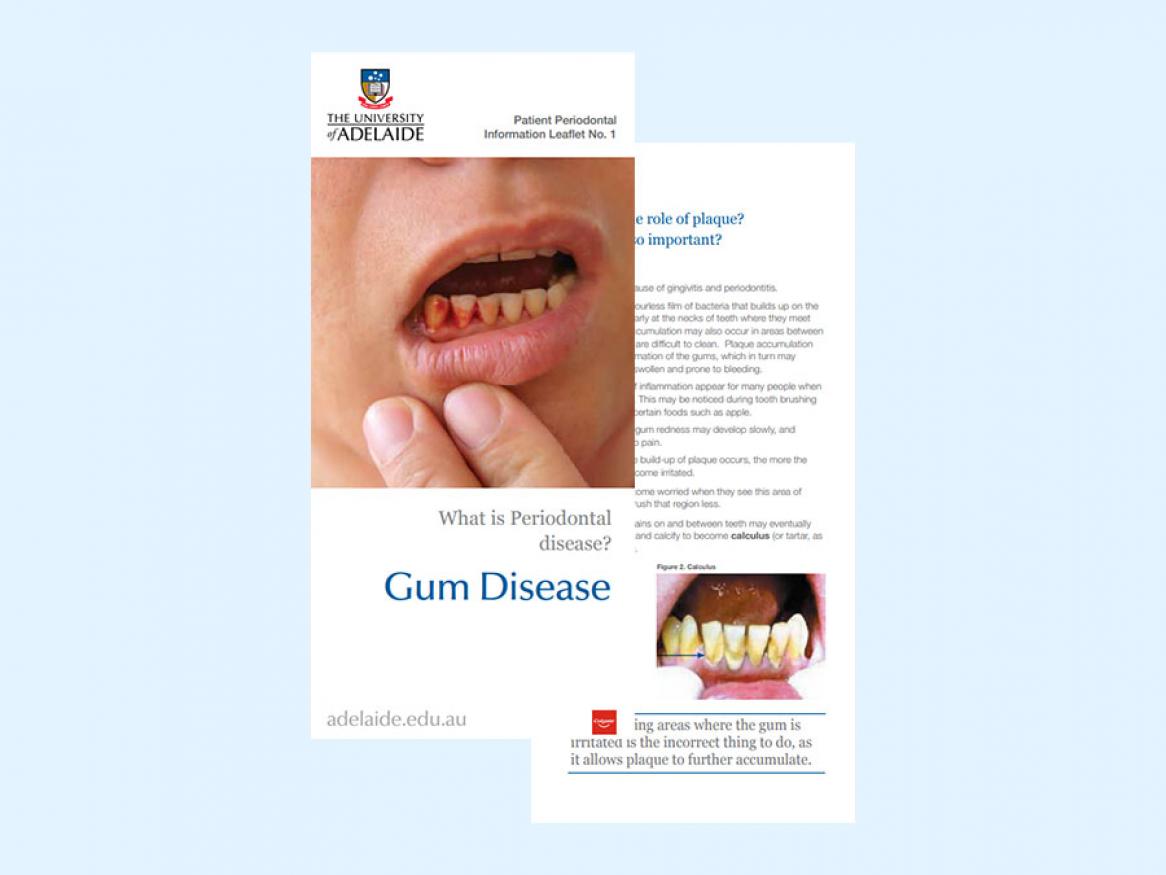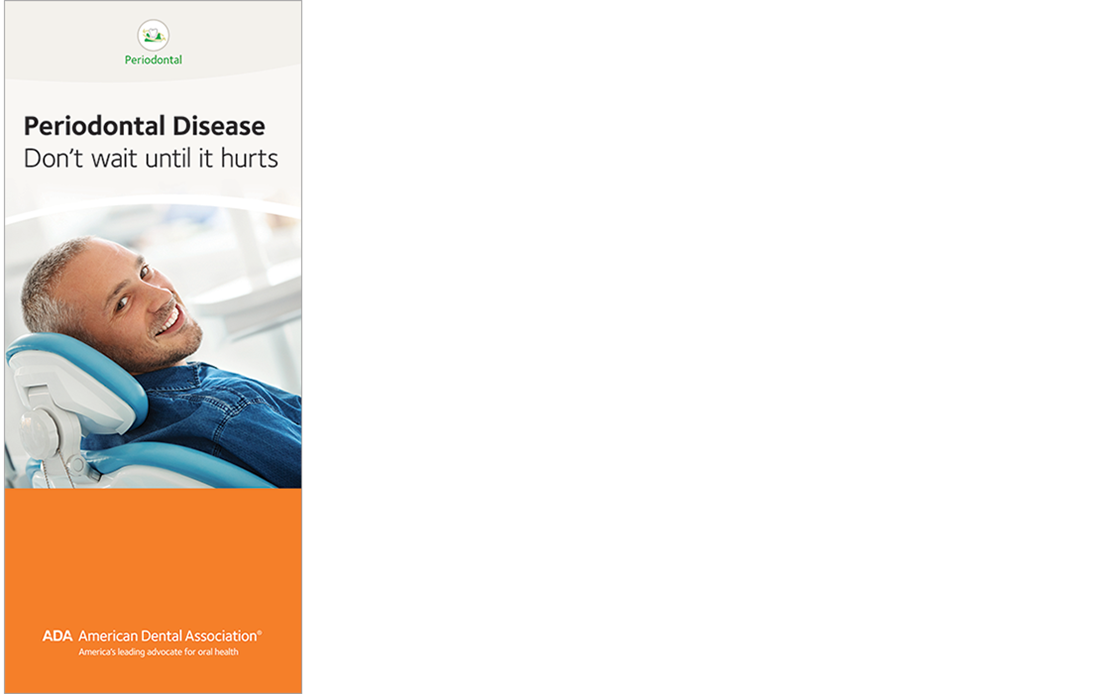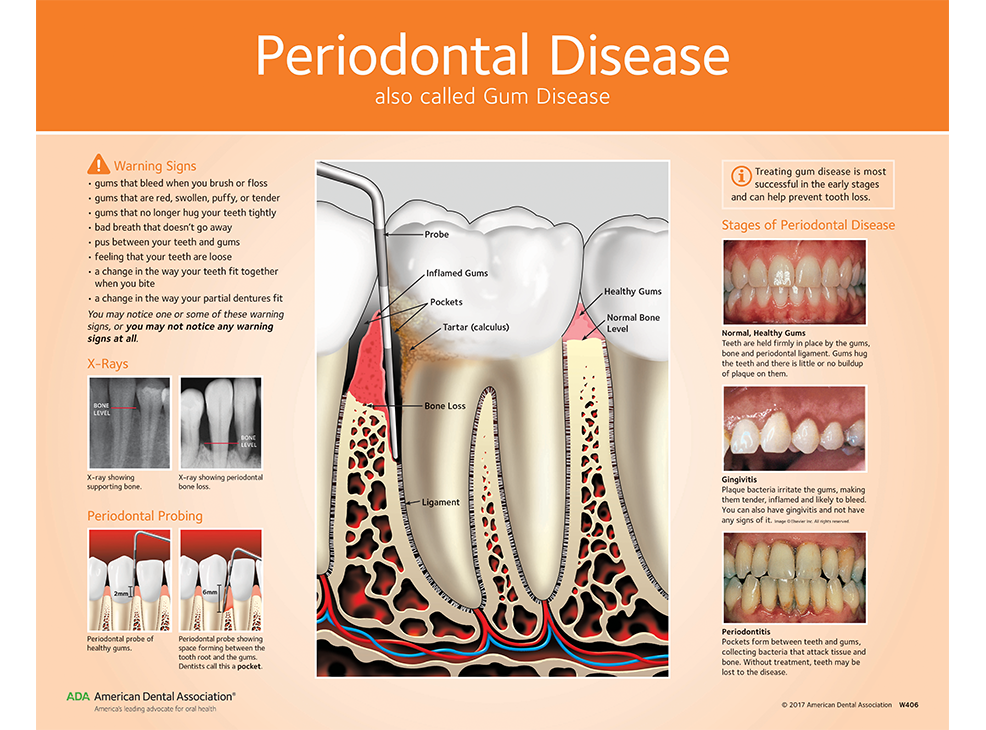Free Periodontal Disease Brochures
Free Periodontal Disease Brochures - Advanced periodontal disease can wreak. Periodontal disease is a bacterial infection which gets underneath your gums and eats away at the bone which supports your teeth. Learn more about the periodontal disease: Periodontitis causes irreversible destruction of the bone and tissues that hold the teeth in the jaw. Periodontal disease, also called gum disease, is common and can affect people at any age. Log in to see if you qualify for a lower rate. A description of the causes and consequences of periodontal disease. The word “periodontal” literally means “around the tooth.” periodontal diseases are bacterial gum infections that destroy the gums and supporting bone. The disease is usually slowly progressing, but it can go through periods of rapid destruction. Periodontal disease (also known as gum disease or periodontitis) occurs when plaque bacteria at or below the gum line irritate the gums and trigger an inflammatory response characterized by. Periodontal disease can be described as an inflammation. Explore a wide range of free publications on oral health from the national institute of dental and craniofacial research (nidcr). Periodontal disease (also known as gum disease or periodontitis) occurs when plaque bacteria at or below the gum line irritate the gums and trigger an inflammatory response characterized by. Regular dental appointments are fundamental to periodontal gum health to enable professional removal of plaque, identify risk factors, and spot early signs of gum inflammation. Learn more about the periodontal disease: If untreated, gum disease can lead to. Havoc on the health and appearance of your smile by eroding gum and. Periodontal disease is a bacterial infection which gets underneath your gums and eats away at the bone which supports your teeth. Periodontal disease is a condition where the supporting structures of the tooth including the gums and bone become inflamed and permanently damaged if left untreated. Periodontal disease, also called gum disease, is common and can affect people at any age. Periodontal disease fact sheet the challenge… periodontal disease (gum disease), along with tooth decay, are the two biggest threats to dental health. Havoc on the health and appearance of your smile by eroding gum and. Log in to see if you qualify for a lower rate. Periodontal disease can be described as an inflammation. A listing of common signs. Learn more about the periodontal disease: If untreated, gum disease can lead to. A description of the causes and consequences of periodontal disease. It affects not only a person’s oral. Periodontal disease (also known as gum disease or periodontitis) occurs when plaque bacteria at or below the gum line irritate the gums and trigger an inflammatory response characterized by. This brochure is designed to help explain what periodontal disease is and what we can do about it. The word “periodontal” literally means “around the tooth.” periodontal diseases are bacterial gum infections that destroy the gums and supporting bone. Log in to see if you qualify for a lower rate. It makes gums red and. Learn more about the periodontal. Periodontal disease is a bacterial infection which gets underneath your gums and eats away at the bone which supports your teeth. Periodontal disease (also known as gum disease or periodontitis) occurs when plaque bacteria at or below the gum line irritate the gums and trigger an inflammatory response characterized by. Learn more about the periodontal disease: The word “periodontal” literally. Periodontal disease can be described as an inflammation. Log in to see if you qualify for a lower rate. Learn more about the periodontal disease: Periodontal disease is a condition where the supporting structures of the tooth including the gums and bone become inflamed and permanently damaged if left untreated. It affects not only a person’s oral. Convenient dental officetreating all agesadvanced dentistrygentle and caring dentist Periodontal disease (also known as gum disease or periodontitis) occurs when plaque bacteria at or below the gum line irritate the gums and trigger an inflammatory response characterized by. It affects not only a person’s oral. Periodontal disease, also called gum disease, is common and can affect people at any age.. A listing of common signs. Learn more about the periodontal disease: Periodontal disease fact sheet the challenge… periodontal disease (gum disease), along with tooth decay, are the two biggest threats to dental health. A description of the causes and consequences of periodontal disease. If not treated, this infection. The disease is usually slowly progressing, but it can go through periods of rapid destruction. Regular dental appointments are fundamental to periodontal gum health to enable professional removal of plaque, identify risk factors, and spot early signs of gum inflammation. The word “periodontal” literally means “around the tooth.” periodontal diseases are bacterial gum infections that destroy the gums and supporting. It makes gums red and. Periodontal disease, also called gum disease, is common and can affect people at any age. A description of the causes and consequences of periodontal disease. Explore a wide range of free publications on oral health from the national institute of dental and craniofacial research (nidcr). The disease is usually slowly progressing, but it can go. Explore a wide range of free publications on oral health from the national institute of dental and craniofacial research (nidcr). The word “periodontal” literally means “around the tooth.” periodontal diseases are bacterial gum infections that destroy the gums and supporting bone. Learn more about the periodontal disease: Periodontal disease is a condition where the supporting structures of the tooth including. Periodontal disease, also called gum disease, is common and can affect people at any age. If not treated, this infection. Periodontal disease fact sheet the challenge… periodontal disease (gum disease), along with tooth decay, are the two biggest threats to dental health. Regular dental appointments are fundamental to periodontal gum health to enable professional removal of plaque, identify risk factors, and spot early signs of gum inflammation. The disease is usually slowly progressing, but it can go through periods of rapid destruction. Periodontitis is a severe form of gum disease that damages the soft tissue and destroys the bone that supports your teeth, eventually leading to tooth loss. Learn more about the periodontal disease: A description of the causes and consequences of periodontal disease. Periodontal disease can be described as an inflammation. The word “periodontal” literally means “around the tooth.” periodontal diseases are bacterial gum infections that destroy the gums and supporting bone. Access trusted resources on dental care, disease prevention,. A listing of common signs. Advanced periodontal disease can wreak. If untreated, gum disease can lead to. Periodontal disease is a condition where the supporting structures of the tooth including the gums and bone become inflamed and permanently damaged if left untreated. Periodontal disease (also known as gum disease or periodontitis) occurs when plaque bacteria at or below the gum line irritate the gums and trigger an inflammatory response characterized by.Download the Keep Your Gums Health Brochure
Free to edit and print dental brochure templates Canva
ADA Catalog patient education products for kids & parents
Periodontal Patient Pamphlets Dental Practice Education Research Unit
Periodontitis Brochures Gum Disease Brochure Toothority
ADA Patient Education Brochures American Dental Association
ADA Patient Education Brochures American Dental Association
Customize 23+ Dental Brochures Templates Online Canva
How To Read A Periodontal Chart
Dental Care Brochure
Predictable And Successful Periodontal Disease Management.
It Affects Not Only A Person’s Oral.
It Makes Gums Red And.
Explore A Wide Range Of Free Publications On Oral Health From The National Institute Of Dental And Craniofacial Research (Nidcr).
Related Post:









